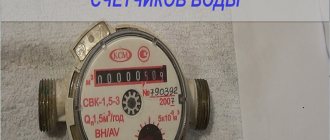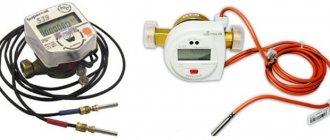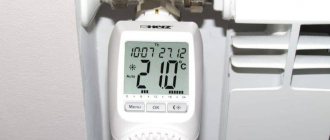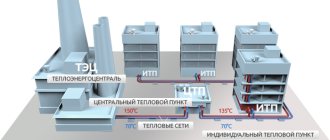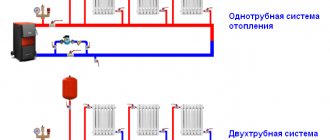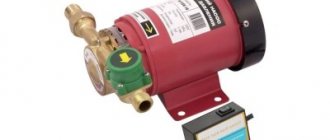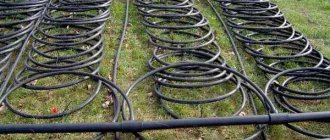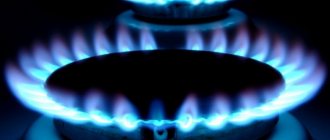DHW fee
thermal energy
component is to be determined based on the consumption of thermal energy used to heat hot water, determined according to the calculated value approved by the heat supply organization.
General calculation formula
To calculate the cost * and “sewage” the formula is used:
“The cost of a service is equal to the product of the volume of service consumed during the billing period and the tariff for this service.”
P
- service cost,
V
– volume of service consumed during the billing period.
T
– tariff for this type of service, for water – price per 1 m3.
* – for , presented in the form of two components, a different calculation method is used.
1. If the living space is equipped
individual metering devices (IMU) for cold water, then the volume of service for the billing period is calculated based on the readings of the metering devices, subject to their timely transfer to the settlement center.
2. If the living space is not equipped
IPU or metering devices do not comply with the requirements of the law, then the volume of service is calculated based on the standards for this service:
Formula 2
:
V cold water = V cold water/norm * N prozh
, where
V hvs
– volume of consumed during the billing period,
V hvs
/norm – standard for ,
N lived
– the number of people living in the residential premises.
Regardless of the method for determining the volume, the cost is determined according to Formula 1.
divided into two components is presented in the EPD as separate lines, since each component is calculated separately.
.
The carrier in is cold water, so the volume of the carrier and its cost are calculated in the same way as (see section “Cold water supply”).
The tariff for , always coincides with the tariff for .
.
Heating water requires thermal energy, which is measured in gigacalories (Gcal). The amount of thermal energy consumed to heat water is calculated by the formula:
Formula 4
:
Q p = V hot water/n * q
, where
Q p
– thermal energy consumed to heat cold water;
V hot water/n
– the volume of cold water (carrier) consumed during the billing period for the purposes of hot water supply;
q
– specific thermal energy consumption, showing how much energy is spent on heating 1 cubic meter. meter of water. It is approved like other utility standards.
The cost is calculated using the formula:
Formula 5
:
P hot water/e = Q p * T te
, where
P hot water/e
- price ;
Q p
– thermal energy consumed to heat cold water (carrier);
T te
– tariff for the component. The price for each supplier is approved by the Moscow Regional Committee.
Apartment building with a common building meter installed ( Staraya Kupavna, Matrosova St., building 14
)
The house has a centralized hot water supply system (closed system)
A resident who has individual metering devices consumed for the billing month 3
cubic meters of cold water and
3
cubic meters of hot water.
The common house meter has readings for the billing month 727,12
cubic meters
(difference of readings: as of 07/31 – 14437.30 cubic meters; as of 06/30 – 13710.18 cubic meters)
Hot water law
The law on hot water supply was adopted in 2013. Government Decree No. 406 states that users of a central heating system are required to pay a two-part tariff. This suggests that the tariff was divided into two elements:
This is how DHW appeared on the receipt, that is, the thermal energy spent on heating cold water. Housing and communal services specialists came to the conclusion that risers and heated towel rails, which are connected to the hot water supply circuit, consume thermal energy to heat non-residential premises. Until 2013, this energy was not taken into account in receipts, and consumers used it free of charge for decades, since the air in the bathroom continued to be heated outside the heating season. Based on this, officials divided the tariff into two components, and now citizens have to pay for hot water.
What is it and what does it look like on the receipt?
DHW (Heating) refers to the total cost of energy spent heating cold water. Hot water in apartment buildings is paid for by residents according to the meter or individual coefficient .
Additionally, the tariff per cubic meter is taken into account, which is set according to the standards of the region where the citizen lives. To find the hot water supply item in the receipt for payment of housing and communal services, you need to look at the “Type of payment” column. In the subsection “Maintenance of common property” there will be a line “DHW. Heating”, which provides information on the tariff, energy consumption rate, SOI coefficient and SME.
Technological process:
- Cold water is supplied to an apartment building.
- With the help of a boiler, heating occurs to the set temperature.
- The water is then supplied to the residents of the house.
Water heating equipment
The equipment that heats the liquid is a water heater. Its breakdown does not affect the hot water tariff, but users are required to pay the cost of repairing the equipment, since water heaters are part of the property of homeowners in an apartment building. The corresponding amount will appear in the receipt for the maintenance and repair of the property.
Important! This payment should be carefully considered by the owners of those apartments that do not use hot water, since their housing has an autonomous heating system installed. Housing and communal services specialists do not always pay attention to this, simply distributing the amount for water heater repairs among all citizens.
As a result, these apartment owners have to pay for equipment they did not use. If you discover an increase in the tariff for repairs and maintenance of property, you need to find out what this is connected with and contact the management company for recalculation if the payment was calculated incorrectly.
Gcal, coolant, hot and network water
— Let the manager explain what we are paying for and how the concepts listed above differ from each other. It is difficult for us, ordinary residents, to maneuver in technical terms.
Question from the site nashdomkch.ru
Sergey Kirilyuk, head of the energy department of the UZHK “Our Home”, answers:
Invoices for heat and hot water presented by heat supply companies may indicate the following tariffs: - per Gcal, (RUB/Gcal); — for network water (rub/t) or for coolant (rub/m3); — for hot water or domestic hot water (RUB/m3)
Not all consumers understand why their bills include a large amount for heat energy (RUB/Gcal), for hot water (RUB/m3), and then a relatively small amount for network water (RUB/m3). T). What is this additional fee? I will not give a dictionary definition of thermal energy, I will try to explain it “on my fingers”.
Think about how hot water differs from cold water, what affects the temperature of the water? It differs in the amount of heat it contains. This heat (or, in other words, thermal energy) cannot be seen or touched, it can only be felt. Any water with a temperature above 0°C contains some amount of heat. The higher the temperature of the water (steam or condensate), the more heat it contains.
Heat is measured in calories, in joules, in MW/h (megawatt per hour), not in degrees °C. Since tariffs are approved in rubles per gigacalorie, we will take Gcal as the unit of measurement. Thus, hot water consists of the water itself and the heat energy or heat contained in it (Gcal). The water seems to be saturated with gigacalories. The more Gcal there are in the water, the hotter it is.
In heating systems, the coolant (hot water) comes in at one temperature and leaves at another. The water releases some of its heat into the environment through heating radiators. For this part, which has not returned to the system, and which is measured in Gcal, someone needs to pay.
With hot water supply, we consume all the water and, accordingly, all 100% of the Gcal in it, and do not return anything back to the system.
What is coolant? All the hot water that runs through the pipes into the heating system or into the hot water supply system, as well as steam and condensate (the same hot water). The word coolant consists of two words - heat and carries. When making calculations, heat supply companies break down the coolant into Gcal and network water, which confuses some consumers.
If previously UZHK “Our House” charged for hot water according to DHW tariffs in rubles/m3, now we break down the coolant for DHW needs. In our invoices for hot water there is no tariff of rubles/m3. We bill for DHW in the same way as for heat, separately for network water and separately for Gcal.
The tariff for network water takes into account only the water itself, and does not take into account the Gcal in it. The hot water tariff takes into account both water and Gcal in it.
Depending on the purpose (for heating or for hot water supply), the coolant is subject to different temperature and sanitary standards. For hot water supply, there is a minimum permissible temperature that must be provided by the heat supply organization, as well as increased quality requirements.
In Kachkanar there is a 2-pipe open heat supply system, from which the hot water supply system in each separate house is powered - this was determined by the project during the construction of the city. In the summer, there is no circulation of the heating system; hot water is supplied through one of the pipes of the heating system (starting from the thermal power plant and to each consumer).
The temperature of the heating fluid depends on the outside air temperature (weather). The colder it is outside, the more we warm it up.
Conclusions: - when paying for heat, you will need to pay for Gcal. When paying for hot water - both for Gcal and for network water (coolant); - coolant - carries heat, hot water, also known as network water + Gcal in it; — network water — water without Gcal; — in life, coolant and network water can mean the same thing.
Tell your friends:
- 1
Thermal energy component
What is this - a coolant component? This is heating cold water. The thermal energy component does not have a meter installed, unlike hot water. For this reason, it is impossible to calculate this indicator using a counter. How, in this case, is the thermal energy for hot water calculated? When calculating the payment, the following points are taken into account:
- tariff set for hot water supply;
- expenses spent on maintaining the system;
- cost of heat loss in the circuit;
- costs spent on coolant transfer.
Important! The cost of hot water is calculated taking into account the volume of water consumed, which is measured in 1 cubic meter.
The size of the energy fee is usually calculated based on the readings of the common hot water meter and the amount of energy in the hot water. Energy is also calculated for each individual apartment. To do this, water consumption data is taken, which is learned from the meter readings, and multiplied by the specific heat energy consumption. The received data is multiplied by the tariff. This figure is the required contribution, which is indicated on the receipt.
Thermal energy for hot water supply in the receipt - what is it? 2021
Modern people prefer to live in comfortable conditions with a minimum amount of inconvenience. Some people even consider it unthinkable that there is no hot water supply in an apartment or private household. But not all consumers of housing and utility services have an idea of what hot water supply is. In the past, installing an independent hot water supply system in rural areas was considered an exclusive and expensive option. Today the situation has changed significantly.
Hot water supply is a service to provide residents and business entities with H2O at a certain temperature. DHW is also an indicator of the standard of living and well-being of citizens. The basis of the natural resource supply system is special equipment, through which the water becomes hot and is supplied to the end consumer. These processes involve: pump, pipes, water heater, fittings and other technical means.
“Rules for the provision of public utilities” (RF RF dated May 6, 2011 No. 354) establish that the water temperature in the hot water system should vary from 60 to 75 degrees Celsius. The indicated values also correspond to the sanitary standards in force in Russia. But the temperature regime may deviate slightly from standard indicators: hot water can be supplied during the day (5.00-00.00) with an error of up to 3°, and at night (00.00-5.00) - up to 5°.
If actual indicators do not comply with established standards, the consumer is given the right to recalculate the resource used. To do this, it is necessary to measure H2O with the participation of representatives of the management company/housing and communal services. Based on the results of the inspection, an act is drawn up, on the basis of which the payment for water heating in an apartment building is adjusted or left unchanged.
There are several schemes by which the resource is brought to the required temperature and supplied to the consumer. The hot water system in an apartment building, operating on a dead-end principle, is designed for round-the-clock use of hot water. If the resource is not completely consumed, the remainder loses the required temperature during transportation and becomes warm. To correct the described drawback, you have to drain the water for a long time, and this is not very convenient.
With the circulation principle of operation of the hot water system, liquid of the same temperature always flows from the tap, but in this case the consumer has to pay more. To stabilize the regime, special pumps are used by analogy with heating systems provided in multi-storey buildings. Hot water can also be provided by differentiating the volume at different temperatures.
At the initial stage, cold water enters from an external network or a central main, then it is heated in a heat exchanger and transported to surface or underground units. This option for providing hot water supply has undeniable advantages.
In particular, there are no toxic substances or toxic impurities in the liquid, and the temperature of the supplied resource is always stable. However, a closed hot water supply system requires the installation of storage or flow-through heaters. It is also necessary to have a supply and return pipeline to ensure circular circulation of the liquid.
Water comes from the taps of the central heating unit. An open hot water supply system is equipped with a coolant that is transported through a pipeline using pumping equipment or naturally. This method of supplying liquid is impeccable even under conditions of risk of leaks, when enormous pressure is created inside the structure.
To provide residents of an apartment building with hot water, a whole range of technical devices is provided. It includes:
- elevator unit – regulates the functionality and quality of the heating system;
- water metering unit – controls the accounting of H2O flow, deactivates the process of supplying cold liquid to all floors for the purpose of carrying out repair work, and carries out its coarse filtration;
- bottlings;
- risers;
- eyeliners;
- boiler/gas water heater.
The internal design of the water supply system must be carried out in strict accordance with SNiP standards (No. 2.04.01-85).
Not all residents of apartment buildings understand this term. What is a thermal energy component? In reality, this is a list of services mediated in the housing and communal services system, with the help of which the temperature of the resource supplied to the consumer increases. They include costs for: maintaining a central hot water system, transporting hot water, heat losses in pipelines. Owners of square meters pay for hot water supply services based on the readings of individual metering devices. In the absence of a meter, DHW is compensated by residents taking into account the established standard.
Those who have a very vague idea of what water heating is, which is highlighted in a separate line on receipts, should know that to increase the temperature and supply liquid, expensive equipment that operates on electricity is needed. In this regard, this service is not cheap for the consumer. To make sure that the amount for hot water in the receipt is calculated correctly, you need to carry out the calculations yourself.
Initially, you should find out the cost of thermal energy, which is set by the authorized body at the regional level (tariff commission). If there is an IPU, it is enough to multiply the amount of resource consumed by the official cost of the resource in the subject of the Russian Federation where the owner of the apartment lives. If there is no meter, then the costs for hot water supply are determined using a special formula by multiplying the regional standard for hot water supply, the established tariff for the specified service, taking into account the financial interests of the resource supplying organization and the number of persons living per square meter.
If the owner of a living space has doubts about the correctness of the calculation of amounts for hot water services, he has the right to contact the Criminal Code for clarification. Including a separate line of expenses for water heating in the receipt is legal if the corresponding decision was made at the general meeting of owners. If you disagree with the accrued amount, a written complaint must be sent to the management company or HOA. If these legal entities ignored the complaint and did not provide a reasoned response within a month, then you should contact the State Housing Inspectorate. If you disagree with the arguments of the housing inspection, it is advisable to take the opportunity to assert your rights in the prosecutor’s office and in court.
Currently, every homeowner should know how to independently make payments for domestic hot water services. Ignoring the verification of accrued amounts in the receipt can transform into a significant overpayment for the supply of a natural resource.
This term refers to the energy consumption for heating water. Thermal energy in the receipt is paid for as hot water supply. This abbreviation is indicated on the payment slip. This simplification is necessary in order not to confuse consumers with technical terminology.
Few people read their bills meticulously. Typically, residents pay attention only to their name and the amount to be paid. However, detailed knowledge on this issue will allow you to identify errors when calculating payments. Usually, when reading a document, abbreviations cause difficulties. It is not always possible to find a current account number. Other problems may arise.
To avoid all of the above, it is recommended to study a sample payment slip. What items should be on the housing and communal services receipt are established by law. The form of the document is also standard.
This is how hot water supply is indicated. However, the payment is not so much for water, but rather for heating it. This is exactly what thermal energy means on the receipt.
This is interesting: Fire safety standards for the construction of an individual residential building 2021
A house may not always be equipped with a centralized heating or hot water supply system. If a water heater is installed in the apartment, you will not have to pay for hot water. The source is important. Thermal energy for hot water supply is what comes from outside: from an autonomous boiler house near the house, from district or city networks.
The last important change in this area was the introduction of a two-tier tariff in 2013. It was since then that people began to pay for hot water supply both for cold water and its heating component. This regulatory act is Government Decree No. 406 of May 13, 2013. The document is constantly changing. The latest amendments were adopted in October 2021. Based on the resolution, a thermal energy component for water heating appeared in receipts. This made the payment more transparent.
The organization of hot water supply and heating is an important issue in public utilities. This industry is being actively researched by scientists. As a result, a lot of classifications are born.
- Systems are divided into intra-house, district, city and inter-regional.
- When determining what the hot water coolant is in the receipt, experts can subdivide it depending on the type of fuel: electricity or gas.
- Systems can be autonomous or centralized.
- Divided into single-pipe or multi-pipe.
However, it is primarily important for consumers to distinguish between open and closed systems. Let's see what the difference is.
The first term means that the apartment receives hot water from the general building network. At the beginning of the season, housing office specialists simply open the valve through which energy enters the heating system. The same unit is also available for domestic hot water supply.
In the second case, hot water is heated directly in the apartment. Moreover, we can talk not only about water supply, but also about heating.
In general, open and closed heat supply systems are equally widely represented in Russian apartments.
If necessary, water heaters or boilers are installed in apartments. Equipment is designed to fulfill a common purpose. But the principle of operation of the two systems is different.
The water heating column passes a flow through itself through a section of the pipe that is subject to strong heating. During that second, while the water passes this section, it acquires the required temperature.
The boiler works on the principle of accumulating water in a tank. The device can maintain the temperature for a long time. However, its disadvantage is that the water takes a long time to heat up.
You only need to pay for hot water if the supply system is open. If there is a water heater in the house, residents consume more gas. Consequently, they receive payment specifically for this resource.
Thermal energy for DHW needs is calculated using a formula taking into account the following factors:
- current tariff;
- consumption of resources for heating water;
- heat loss coefficient.
That is, consumers themselves, not suppliers, pay for the loss of heat that inevitably occurs during the passage of boiling water through pipes.
This is what the component for thermal energy in DHW is. This is compensation for water heating, which is carried out by utilities.
Tariffs of management companies are not always objective. If you don’t check them and don’t appeal the receipts, the inflated bills will continue to be sent to the owners. Let's look at how to calculate the thermal energy for hot water supply.
- tariff per cubic meter of cold water supply;
- volume of domestic hot water consumption (according to the meter on the hot water pipe);
- established and not changing standard for heating 1 m3 of water at the current tariff.
Typically, when setting the price of a heat energy component, the management company carries out its own calculations, the results of which are notified to residents at general meetings. If the management company arbitrarily increases the cost of hot water supply in the future, its actions can be appealed. The court in this case is not the only possible authority.
First of all, don't be patient. Until the error is appealed, unfair charges will continue. If heating the hot water supply in the receipt has become a controversial issue, you can try contacting the management company itself. It is not uncommon for companies to meet consumers halfway and make recalculations.
However, if there is an error in the receipt for utilities, and the management company does not want to notice it, you can contact:
- to Rospotrebnadzor;
- Federal Antimonopoly Service;
- the prosecutor's office;
- court.
Sometimes a line with DHW appears on the receipts of residents who do not actually receive this service. Such a criminal offense can be punished with serious fines and a recalculation can be achieved.
However, even in cases of blatant arbitrariness, one cannot refuse to pay bills. Until the end of the proceedings, any non-payment will be treated as an accruing debt.
The thermal energy component is one of the components of payment for hot water supply. It is calculated by specialists based on the communications of a particular house. Prices for hot water should not increase without the approval of government agencies or a meeting of residents. In case of arbitrariness of the Criminal Code, the company’s actions must be appealed and justice sought.
Recently, a line called DHW has appeared in utility receipts. Many residents do not understand what it is and do not enter data into it. Or the indicators of this line are not taken into account when paying. As a result, they have debts and penalties accumulate. All this, when a large amount of debt accumulates, can lead to fines and legal proceedings with subsequent shutdown of heating and hot water supply in winter.
Water supply and heating can be carried out in two different options. The central supply system is typical for apartment buildings. In this case, the water is heated at a thermal station and from there supplied to homes.
An autonomous system is used in private homes where a central system from a thermal station is not possible or unprofitable. In this case, the water is heated by a boiler or boiler, and hot water is supplied only to specific rooms of one house.
The DHW line in utility bills indicates the energy that was spent heating water. And only residents of apartment buildings pay for it. Users of an autonomous system spend electricity or gas to heat water, so they will pay the costs of these coolants accordingly.
Utility payments have the same forms for everyone, so if such documents are sent to both residents of multi-storey buildings and those living in the private sector, then owners of individual houses need to be very careful not to pay for unnecessary services.
Hot water supply to houses, heating in winter with hot water is one of the most expensive services among utility bills. Therefore, today experts have divided it into two parts in order to take into account all components of the process. Now tariffs for water heating are called two-component. One part is the supply of cold water to users. The second part is heating the water.
Experts found that heated towel rails and risers in bathrooms heated the rooms in residents’ apartments for a whole year. As a result, thermal energy is wasted, which also has to be paid for. For decades, the loss of this energy was not taken into account , and the population used it for nothing.
This is interesting: Fines for failure to post information in the Housing Information System for 2021
Now we decided to calculate all the expenses for heating water, adding in the heat consumption through risers and dryers. That is why a hot water supply point was introduced.
In the DHW line, another column appears, which is also not clear to the population - ODN. This reduction hides general house needs, that is, heating of common areas - corridors, landings, flights of stairs, repair work, during which hot water is wasted. They are divided among all residents, since all residents of the house use the stairs, corridors, and halls, where the radiators are located and the air is heated. Therefore, you also need to pay ODN.
There may also be common water heating devices in the house for heating domestic water. If there is such a device in the house, it may break down periodically.
Its repair will also cost a certain amount, which will be distributed among all residents, and it will appear in utility bills. However, in a multi-storey building there may be apartments that have refused hot water. They are supplied only with cold water.
Very often, housing office workers may not pay close attention to this issue and issue utility bills for water heating to those users who do not receive hot water. In this case, you need to keep track of utility bills, and if there is a payment for services that the apartment does not receive, you need to contact the housing office with a request for recalculation.
If a person is not sure that his payments for heating and hot water were calculated correctly, he can recalculate himself. To calculate, you need to know the tariff for water heating. Also, if there are meters in the apartment, their readings must be taken into account. If the house has a common hot water meter, then the water consumption for the apartments is calculated.
In the absence of meters the average standard established by the company providing the coolant combustion is taken. In general, meter readings for energy consumption are multiplied by the volume of water consumed. The resulting figure is multiplied by the tariff.
If a person has determined that he has to overpay a lot for heating, he can contact a company that provides water heating services. The company must respond within 13 days. If you need to complain about a company providing water heating services, you can contact Rospotrebnadzor.
If you have questions about tariffs, you can contact the Federal Tariff Service. Also, a resident of an apartment can appeal to the court and the prosecutor’s office if he believes that he is being forced to pay for services that he does not receive, or if the company is adding amounts to utility bills for which it did not provide services.
Housing and communal services receipts for payment of utility services sometimes contain strange names and abbreviations: abbreviations GVS KPU, GVS DPU, etc. This makes consumers nervous and suspicious of tariffs and accrued payments. Regulation of tariffs for hot and cold water supply, as well as sanitation, is carried out by the state, on the basis of Russian Government Decree No. 406, adopted back in 2013. This article contains information in simple words:
- explanation of what DHW KPU (DPU) and water heating are;
- calculation of consumed thermal energy;
- checking the correctness of charges for hot water supply in the receipt.
- DHW KPU - hot water supply according to control metering devices;
- DHW DPU - hot water supply via household metering devices.
Hot water control units can be installed in apartments and used as individual metering devices for hot and cold water consumption. The housing and communal services receipt must indicate the readings of both communal and individual meters.
Payment for hot water supply is charged only if there is a central hot water supply, while water is used both as a heat carrier for heating premises and for domestic needs (as hot water).
- If there is hot water in the house, then consumption should be recorded using two general house or individual meters: one is installed on the hot water risers and shows the consumption consumption in cubic meters, the other - on the branch of the heating system and shows the amount of thermal energy consumed in Gcal.
- In houses where there is only cold water, charges for hot water are charged only during the heating season.
- If an apartment uses a boiler or gas water heater to heat water, residents pay for the energy consumed (electricity or gas).
- Some MKD apartments use a dual-circuit heating system: one is connected to the central hot water supply system;
- the other to individual internal water heaters (in case the hot water is turned off).
According to section II, clause 4 of post. No. 406, regulated state tariffs for hot water supply consist of tariffs of the following type:
- for hot water;
- for transportation through the central hot water pipeline;
- to connect the in-house system to the central system (CS) of hot water supply.
Clause 88 of Resolution No. 406 establishes a 2-component tariff for hot water, which consists of a component for cold water and a component for thermal energy (or water heating).
Thus, the cost of hot water Sgw is determined as the sum of the costs of cold water Sxv and its heating (heat energy) Ste:
Previously, the cost of hot water was determined by the following formula:
Vgv - volume of hot water consumed,
Tgv - tariff for hot water (cost of one cubic meter of hot water).
For reference: The cost of one cubic meter of hot water in Moscow in the second half of 2021 is 188.5 rubles per cubic meter.
Attention! If payments for hot water in housing cooperatives or management companies are carried out according to the old one-component tariff for hot water, then residents should not be charged for any water heating!
Calculation of the cold water component
The cold water component is determined:
- at the standard price of one cubic meter (single-rate system);
- at the price of a cubic meter plus expended power per hour per 1 m³ of water (according to a two-rate system).
That is, the tariff for cold water can also be composed of two components.
If water is taken from a water supply source by some third-party organization that has the right to do so, or is processed to turn it into drinking water, then the tariff for cold water can be set based on the material costs of this organization per 1 m 3 of water.
Formula for determining the cost of cold water Sхв used for hot water supply:
where V is the consumed volume, which is removed from the hot water meter;
Тхв - tariff for cold water.
Thermal energy is the power required to heat water, measured in gigacalories.
This is interesting: Competition to select a management organization for an apartment building 2021
That is, this is the same “water heating” that can be indicated on the receipt as part of the tariff for hot water. It is included in this tariff along with the cold water component, and is not a separate fee. (Explanation for those residents who are sure that the housing and communal services authorities charge them double fees for hot water). At the same time, the receipts additionally indicate the fee for cold water, since this is a separate type of utility service.
It was decided to introduce a two-component tariff to take into account energy and transportation costs, as well as heat loss. In this case, according to the law, only heat losses along the path from the central coolant supply points to the entry point into the houses are taken into account. That is, no losses from heated towel rails and risers in the premises should be taken into account.
The thermal energy tariff component consists of:
- from the cost of one unit of thermal energy (gigacalories or Gcal), established on a legislative basis;
- financial costs of organizations regulated by the state for the maintenance of central hot water supply from the points of thermal power plants to the point of operational inputs of the zone of responsibility of consumers and organizations;
- the cost of heat loss of one unit of thermal energy (1 Gcal) in pipelines from central heating points to the entrance to the end-user areas;
- cost of water transportation.
The tariff for thermal energy in the second half of 2021 for the Moscow region ranges from 977 to 1025 rubles. for 1 Gcal.
How is the thermal energy component determined?
The thermal energy component, according to the decision of the Supreme Court of the Russian Federation dated July 10, 2021, is determined according to regulatory Rule No. 354:
This is the amount of thermal energy spent on heating the volume of water consumed by the consumer, which is determined not by metering devices (KPU or DPU), but by standard indicators of heat consumption for heating.
If we take the amount of energy for heating water as a certain value Qgw, then the cost of thermal energy Ste, at the heat tariff Tte, can be determined by the formula: Ste = Qgw x Tte (4).
In this case, Qgw is calculated according to the thermal energy standard per cubic meter of water and the volume of water consumed:
where V is the volume of hot water (according to the hot water meter);
Npv is the standard for heating one cubic meter of water (on average it ranges from 0.05 to 0.07 Gcal/m3).
The cost of hot water is calculated as follows:
- according to metering devices (hot water meters) - they determine the volume of water consumed, and according to formula (3) the cost of the first component - cold water;
- using formula (4) for calculating the cost of thermal energy, the cost of the second component is determined;
- add both components.
In addition to the payment for hot water, the receipts indicate the payment for heating, which is calculated according to the readings of communal or individual heat energy consumption meters.
If there are neither communal nor individual meters, then payments for hot water and heating are calculated according to average standard indicators established by regional authorities:
- standard water consumption per person per month (it is inserted into lines (3) and (5) instead of the volume of water according to the meter);
- standard consumption of thermal energy per square meter of total area;
To determine the cost of heating, it is necessary to multiply the standard indicator of thermal energy consumption by the area of the heated premises of the apartment, and multiply the resulting result by the tariff (the cost of one Gcal of heat).
- The cost of hot water according to a common house meter: the number of cubic meters of hot water consumed per month in the house is divided by the number of residents in the house - you get the average volume of water consumption Vavg. for one person;
- Vavg. insert into the lines (1) - (5) instead of V.
- Vted - the volume of thermal energy consumed by the house per month according to the general house thermal energy meter;
Repairs of pipelines, water heaters, filling the system before the heating period, draining coolants and other work are not included in the domestic hot water tariff, but are paid in separate columns of receipts: operating costs, technical work, repairs, etc.
It is very difficult to control utility bills here. It is due to all these additional payments that the unaccounted profits of housing and communal services and management companies are formed. There are also proven techniques for installing hidden plugs on the heating system of a house behind the meter, which allows you to reduce the supply of real heat to apartments.
The controlling body for housing and communal services, housing cooperatives and management companies is the State Housing Inspectorate. This is where residents should file complaints if they think that the payment for hot water supply is too high.
The housing inspection is obliged to consider the appeal and respond to it within a month. If the complaint is found to be justified, GZHI inspectors will inspect the hot water supply in the house.
If the complaint is rejected, you can appeal to the courts by filing a claim with representatives of the housing and communal services, housing cooperatives, HOAs or management companies (depending on the nature of the claim).
Even if the money for hot water supply has been paid, then if violations and incorrect calculations are detected when charging fees by the relevant organizations, the paid funds must be returned to the residents. Otherwise, the persons responsible for returning the money, on the basis of Art. 395 of the Civil Code of the Russian Federation, will be forced to return the amount of the debt with interest or pay a penalty for failure to fulfill obligations (if the condition for payment of the penalty is contained in the agreement between the parties (suppliers, organizations and consumers).
- Hot water supply in apartment buildings can be controlled using metering devices (both individual and communal). Almost all MKDs have meters installed to control the hot water supply of the KPU (DPU).
- Calculation of the cost of hot water consists of two components: the cost of cold water and the cost of heating it
- One receipt cannot contain double charges (for both hot water and water heating), since the cost of water heating is included in the cost of hot water).
»
Other
How to kick a homeless person out of the entrance: where to turn 2021
Read more
Other
How to pay housing and communal services through Alfa Bank without commission 2021
Read more
Other
How to transfer electricity readings on a personal account 2021
Read more
Great article 0
How to make your own calculation
Not all users trust the payment center, which is why the question arises of how to calculate the cost of hot water supply yourself. The resulting figure is compared with the amount on the receipt and on the basis of this a conclusion is made about the correctness of the charges.
To calculate the cost of hot water supply, you need to know the tariff for thermal energy. The amount is also affected by the presence or absence of a meter. If there is one, then readings are taken from the meter. In the absence of a meter, the standard for the consumption of thermal energy used to heat water is taken. This standard indicator is established by an energy saving organization.
If an energy consumption meter is installed in a multi-storey building and the housing has a hot water meter, then the amount for hot water supply is calculated based on general building metering data and the subsequent proportional distribution of the coolant among apartments. If there is no meter, the rate of energy consumption per 1 cubic meter of water and the readings of individual meters are taken.
Complaint due to incorrect calculation of receipt
If, after independently calculating the amount of contributions for hot water supply, a difference is identified, you must contact the management company for clarification. If the organization's employees refuse to provide explanations on this matter, a written complaint must be submitted. Company employees have no right to ignore it. The response must be received within 13 working days.
Important! If no response is received or it is not clear from it why this situation arose, then the citizen has the right to file a claim with the prosecutor’s office or a statement of claim in court. The authority will consider the case and make an appropriate objective decision. You can also contact organizations that control the activities of the management company. Here the subscriber's complaint will be considered and an appropriate decision will be made.
Electricity used to heat water is not a free service. Payment for it is charged on the basis of the Housing Code of the Russian Federation. Each citizen can independently calculate the amount of this payment and compare the data obtained with the amount on the receipt. If any inaccuracy occurs, you should contact the management company. In this case, the difference will be compensated if the error is recognized.
